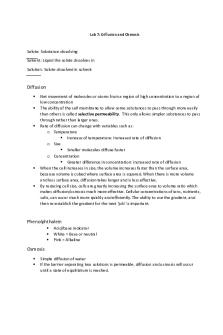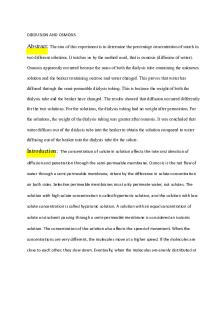Diffusion and Osmosis - SCB 201 LAB PDF

| Title | Diffusion and Osmosis - SCB 201 LAB |
|---|---|
| Course | General Biology I |
| Institution | LaGuardia Community College |
| Pages | 5 |
| File Size | 142.3 KB |
| File Type | |
| Total Downloads | 26 |
| Total Views | 130 |
Summary
SCB 201 LAB...
Description
DIDDUSION AND OSMOSIS
Abstract: The aim of this experiment is to determine the percentage concentration of starch in two different solutions. It teaches us by the method used, that is osmosis (diffusion of water). Osmosis apparently occurred because the mass of both the dialysis tube containing the unknown solution and the beaker containing sucrose and water changed. This proves that water has diffused through the semi-permeable dialysis tubing. This is because the weight of both the dialysis tube and the beaker have changed. The results showed that diffusion occurred differently for the two solutions. For the solutions, the dialysis tubing had no weight after permeation. For the solutions, the weight of the dialysis tubing was greater after osmosis. It was concluded that water diffuses out of the dialysis tube into the beaker to obtain the solution compared to water diffusing out of the beaker into the dialysis tube for the solute.
Introduction:
The concentration of solute in solution affects the rate and direction of
diffusion and penetration through the semi-permeable membrane. Osmosis is the net flow of water through a semi-permeable membrane, driven by the difference in solute concentration on both sides. Selective permeable membranes must only permeate water, not solutes. The solution with high solute concentration is called hypertonic solution, and the solution with low solute concentration is called hypotonic solution. A solution with an equal concentration of solute and solvent passing through a semi-permeable membrane is considered an isotonic solution. The concentration of the solution also affects the speed of movement. When the concentrations are very different, the molecules move at a higher speed. If the molecules are close to each other, they slow down. Eventually, when the molecules are evenly distributed at
equal concentrations on each side of the membrane, the system is in equilibrium and the molecules are no longer moving.
Methods & Materials: Tube bags dental floss 5% sucrose 15% sucrose DH2O 4 beakers pipets 1. First taken dialysis tube folded over one end of each length of tubing and tie it tightly with a length of thread. 2. Place the open end of one dialysis bag over the funnel stem. Used a 10 ml pipette to fill each dialysis bas as follows: Bag 1: 10 ml Water Bag 2: 10 ml 5% sucrose solution Bag 3: 10 ml 15% sucrose solution Bag 4: 10 ml Water 3. Each dialysis bag had been folded the open end and squeeze from the tied end to remove as much air as possible and tied with the remaining pieces of thread. 4. Each bag had been rinsed off in the pan of water and gently pat them dry with a paper towel and weighed. 5. The 250 ml beakers 1-4 had been numbered. Filled the beakers 1-3 with 200 ml of water. Beakers had been filled with 200 ml of 30% sucrose solution. 6. Each bag had been placed in the corresponding numbered beaker. 7. After 1 hour removed each bag from its beaker and gently pat dry with a paper towel and weigh. 8. And then data had been recorded in the table. Results: Table 2: Change in mass of dialysis bags undergoing osmosis Bag Contains Beaker Contains
dH2O dH2O
5% Sucrose dH2O
15% Sucrose dH2O
dH2O 15% Sucrose
0 min 15 mins 20 mins 45 mins 60 mins
11.2g 11.2g 11.2g 11.2g 11.3g
11.2g 11.8g 12.5g 13.4g 13.8g
11.2g 13.8g 14.5g 14.8g 15.2g
11.2g 10.4g 10g 9.5g 9g
Q1. DESCRIBE THE CHANGES THAT OCCURRED IN EACH DIALYSIS BAG? Bag 1 - no change in weight - bag appeared same before and after the experiment Bag 2 - weight gain - bag appeared swollen/enlarged after the experiment Bag 3 - weight gain - bag appeared even more swollen/enlarged after the experiment as compared to bag Bag 4 - weight decrease - bag appear small/shrinked after the experiment Q 2. REPORT THE DIRECTION OF NET WATER MOVEMENT FOR EACH BAG? Bag 1 - no net movement of water across the bag, therefore we can conclude that the solution in beaker was isotonic. Bag 2 and bag 3 - water moved inside the bag, therefore we can conclude that the solution in beaker was hypotonic. Bag 4 - water moved outside the bag, therefore we can conclude that the solution in beaker was hypertonic. Q3. WHICH BAG GAINED THE MOST MASS? Bag 3 gained most weight. It is because the solution surrounding this bag was more hypotonic than the solution surrounding bag 2 which also gained weight. Background information Osmosis is the movement of solvent molecules of water molecules through a selectively permeable membrane from a region of higher concentration to a reason of lower concentration. It is a passive process. Conclusion: Diffusion is the movement of particles from an area of higher concentration to an area of lower concentration. The diffusion of water in and out of a selectively permeable membrane is called osmosis. Because of the selectively permeable membrane, nothing but water and other very small particles can diffuse by osmosis. The cell membrane is similar to a dialysis tube in that if a cell is placed in an environment where the concentration of water is greater than the cell, it will lose water due to osmosis. The solution on the dialysis tubing has a higher solute concentration (15% sucrose, 5% sucrose) than the distilled water/iodine solution. The beaker represents a hypotonic solution in which the concentration of dissolved substances is lower than
the concentration in the dialysis tubing. Osmosis causes water to pass through the dialysis tubing into the bags. The increase in mass of the three bags indicates that water enters them. The dialysis bag represents a hypertonic solution in which the concentration of dissolved substances is greater than the concentration outside the dialysis bag. Osmosis causes glucose to pass through the dialysis tubing into the beaker. The glucose test paper shows that glucose is coming out of the bags.
Reference Keller, Charles, Alzeory, Sherouk, Fuentas, Lucia. 2016.General Biology 1. LaGuardia community college, Second edition lab manual....
Similar Free PDFs

Diffusion and Osmosis lab
- 3 Pages

Diffusion and osmosis lab
- 4 Pages

Diffusion and Osmosis lab
- 4 Pages

Lab 7: Diffusion and Osmosis
- 2 Pages

Lab 4 - Diffusion and Osmosis
- 6 Pages

Lab 4 Diffusion and Osmosis
- 7 Pages

Lab 5 Diffusion and Osmosis
- 1 Pages

Diffusion and osmosis lab 1
- 4 Pages

Diffusion and Osmosis Lab Report
- 8 Pages

Diffusion and Osmosis Lab Report
- 8 Pages

Diffusion & Osmosis Lab
- 10 Pages

Diffusion and Osmosis Worksheet
- 2 Pages

210 diffusion and osmosis
- 5 Pages
Popular Institutions
- Tinajero National High School - Annex
- Politeknik Caltex Riau
- Yokohama City University
- SGT University
- University of Al-Qadisiyah
- Divine Word College of Vigan
- Techniek College Rotterdam
- Universidade de Santiago
- Universiti Teknologi MARA Cawangan Johor Kampus Pasir Gudang
- Poltekkes Kemenkes Yogyakarta
- Baguio City National High School
- Colegio san marcos
- preparatoria uno
- Centro de Bachillerato Tecnológico Industrial y de Servicios No. 107
- Dalian Maritime University
- Quang Trung Secondary School
- Colegio Tecnológico en Informática
- Corporación Regional de Educación Superior
- Grupo CEDVA
- Dar Al Uloom University
- Centro de Estudios Preuniversitarios de la Universidad Nacional de Ingeniería
- 上智大学
- Aakash International School, Nuna Majara
- San Felipe Neri Catholic School
- Kang Chiao International School - New Taipei City
- Misamis Occidental National High School
- Institución Educativa Escuela Normal Juan Ladrilleros
- Kolehiyo ng Pantukan
- Batanes State College
- Instituto Continental
- Sekolah Menengah Kejuruan Kesehatan Kaltara (Tarakan)
- Colegio de La Inmaculada Concepcion - Cebu


